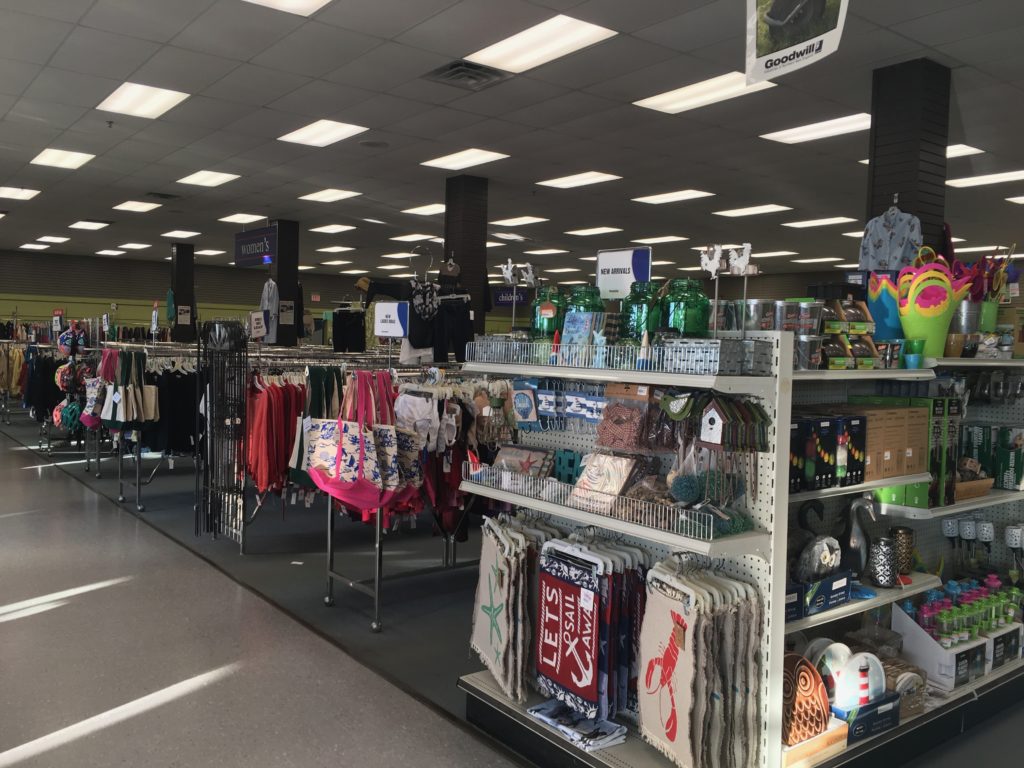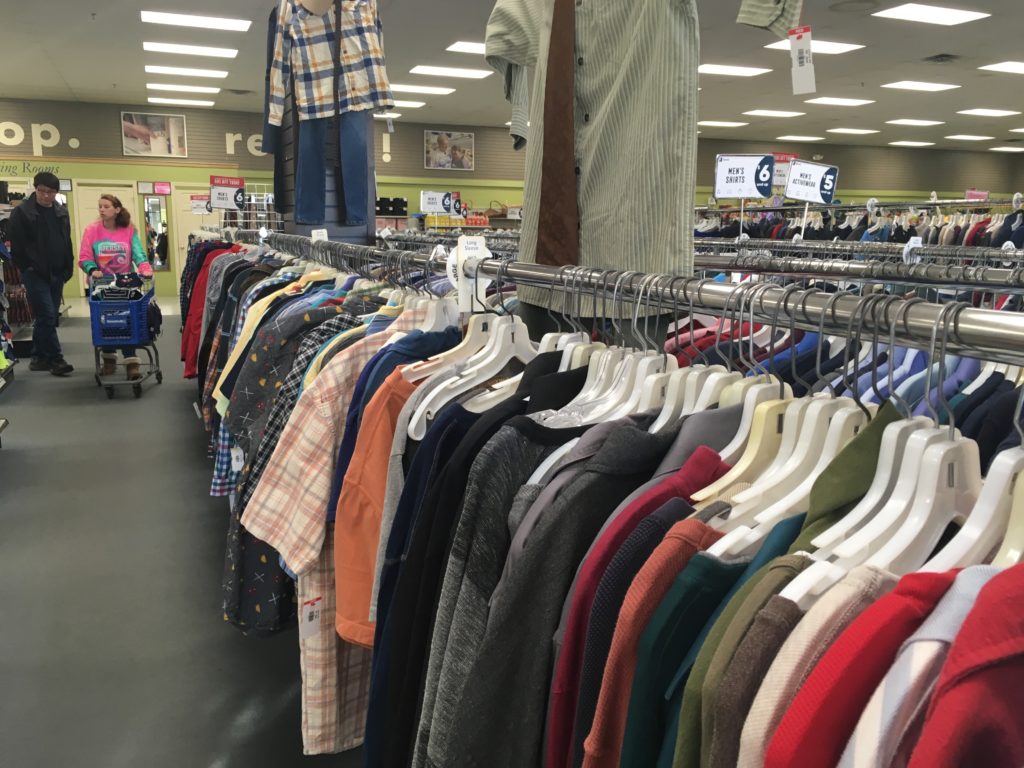Tips for the modern treasure hunt for thrift store finds

Since “The Life-Changing Magic of Tidying Up” was added to Netflix’s queue, second-hand stores nationwide have reported an uptick in donations. And that means that Marie Kondo-mania has left thrift stores flooded with fantastic thrift store finds.
Whether you are trying to save money on garden supplies or looking for troughs for your chicken coop, the thrift store is likely your best source for cheap, quality materials. Plus, reusing materials instead of buying new reduces the impact of creating new goods on the planet’s material and energy resources.
Because thrift stores’ stocks are dependent on what is donated there, location matters when choosing where to shop.
“We rely on donations of neighbors,” Shauna Werner, vice president of the Leeward Charitable Foundation, which runs two thrift stores in York, Maine, and Salisbury, Massachusetts. “I would pay attention to the communities surrounding that thrift store. That’s going to give you an idea of what the quality of the donated items will be”
Werner said you can turn to the internet with search engines like Google and Yelp to find quality second-hand stores by you, but she said sometimes asking your neighbors is the best thing you can do to find a good thrift store.
“Word of mouth from neighbors is our biggest draw,” Werner said. “We don’t have to do a lot of advertising. A lot of word of mouth in local communities is what we rely on heavily.”
In Maine, certain thrift stores stand above the rest for homesteading supplies. Though she admitted bias, Werner recommended the thrift store in York run by the Leeward Charitable Foundation, which is called Leeward Light Thrift Store.
“At our organization, we are extremely fussy,” Werner said. “Everything goes through our hands inspected, cleaned and priced. The chances of finding something damaged in my store would be slim.”
There are other thrift stores in Maine that are especially good if you are looking for a bargain.
“Goodwill Buy the Pound is my favorite place,” said Mary Plummer Lerley, a homesteader based in Gorham, Maine. “It’s located right here in Gorham and is a real gem. You have to be willing to dig and scrub, but it’s kind of magical.”
Go often
Once you have chosen your favorite thrift store, one of the best things you can do is frequently visit to check for new inventory.
“My biggest advice is that if you have a local thrift store is to go there often because the inventory changes so quickly,” Werner said. She suggested making friends with your favorite thrift store’s employees so they can tell you when new shipments come in.
“Even volunteer there,” Werner suggested. “Volunteering there would really give first dibs.”
The content of the thrift store will depend on what has recently been donated.
“They’re always hit or miss but you never know,” Werner said. “You pull up and the whole thing could be filled with yard goods and planters.”
Werner said the best time to get garden supplies and tools is “at the end of the season or beginning when people are taking things out and saying, ‘Oh, I don’t need this this year,’” but you can use thrift stores to get a number of different things for your homestead if you know what to look for.
Here are the best things to get for your homestead at a thrift store, as well as some tips for thrift shopping.
Cast iron pans

Because they are so useful in the kitchen, cast iron pans are useful in the kitchen, but they can be expensive. You can easily and cheaply get a quality used cast iron pan at the thrift store if you know what to look for.
“I look for smooth, well-loved cast iron pans,” said Meredith Josselyn, a homesteader based in Dexter, Maine. “A little bit of rust can be taken care of, but I tend to avoid deep scratches or pitting.”
To remove rust from an old cast iron, use a fine steel wool and scour until the original color shows through. Wash with hot water and dish soap, dry immediately with a paper towel, douse the inside and outside with a coat of vegetable oil or olive oil and heat it at 350 degrees in the oven (upside down on a sheet of aluminum foil, to prevent dripping).
“For cast iron, I look for thickness and surface cracking,” said Mary Plummer Lerley, a homesteader based in Gorham, Maine. “Sometimes older pieces have worn thin in areas, or weren’t cared for correctly. I have rarely come across cast iron that wasn’t salvageable.”
Kitchenware
Besides cast iron pans, you can get a wide variety of quality kitchenware at the thrift store. Expensive items like stock pots and roasting pans can be found at much lower prices, often in good condition.
“I know how expensive pots and pans are,” Werner said. “At our store you pay a dollar or two dollars for something that would be $5 or $20 at the outlets, like whisks and spatulas. The kitchen items that we get are really incredible.”
Keep an eye out for items made from stainless steel and ceramic, which are less likely to rust. Avoid nonstick pots and pans, which are prone to scratching and can release toxic chemicals if heated too hot. Also avoid plastic of indeterminate age, as the dangers of chemicals like bisphenol-A have only been known and acted upon for the last decade or so.
Thrifted kitchenware can also be used in other places around your homestead. Lisa Steele, blogger at Fresh Eggs Daily, recommended repurposing thrifted enamelware pans as feeders and waterers. She also said you can use ladles to hold eggshells or oyster shells and to provide them with calcium and grit to aid digestion.
Homesteading books
Your local thrift store is a great source for used books, especially instructional guides. If you are trying to develop new skills around your homestead and maybe revive some skills that have been lost to the modern day, keep an eye out for old cookbooks and other homesteading books.
“[Look out for] books on woodworking, herb gardens [and] beekeeping,” Josselyn said. “[You] can’t have too many of those either.”
Canning equipment
If you are just getting started with canning and fermenting, you can find a wealth of supplies at your local thrift store, particularly mason jars, pressure canners and water bath canners.
Check for cracks in the jars, especially on the upper mouth, and inspect the bands to make sure they are rust-free and round. Pressure canners should have working seals and come with all the necessary weights. Water bath canners should also be free of rust and holes, so look over the equipment thoroughly before you purchase it.
Canning health standards have changed over the years, though, so this is one instance where you can skip the book section at your local thrift store. If you are just getting started with canning, purchase an up-to-date book to outdated information that could lead to food-bourne illness.
Furniture
The thrift store is a great source for inexpensive furniture, especially outdoor furniture that will be exposed to the elements and wood furniture that is easy to wipe down. Most surfaces can be refinished, but check to make sure the pieces are free from foundational cracks.
You can also buy upholstered furniture like sofas and armchairs, but there are a few rules you should follow.
“Definitely lift every cushion and do a complete 360 around that piece of furniture,” Werner said. “It’s even worth it sometimes to tip it over and kind of look underneath to make sure there’s nothing dirty or wet or moldy.”
Flannel shirts

Every homesteader knows that you can never have too many flannel shirts. They are not just useful for the homesteading aesthetic, but the dense, tight wool weave is a great barrier against body odor and adverse weather, which is especially useful for homesteaders working outside in cold conditions.
For quality flannel, materials matters. Keep an eye out for 100 percent cotton (or, for more intense cold climates, 100 percent wool) shirts and avoid synthetic fabrics.
“I tend to look for men’s flannel shirts, mostly L.L. Bean, or Woolrich wool shirts,” Josselyn said. “They’re decently made and can handle what I’ll put them through. I also don’t have to stress about spending $20 [or] $30 on a brand new shirt that is going to be used and abused by working in the garden.”
Sheets, blankets and towels
Though you may shudder at the idea of using someone’s old sheets, blankets or towels, consider shopping at the thrift store for these items when you plan to use them in other ways around your homestead.
Josselyn said she always keeps an eye out for flannel blankets and sheets that can be turned into insulated window curtains for winter.
“I use [them] to back my curtains to add an extra layer during the winter,” she explained. “Just safety pin them up and take them down in the spring.”
You can get very good prices at the thrift store, and Werner said that at her store at least, they are often cleaned before they are put out.
“They are two and three dollars,” she said. “You could use them for pets or cleaning, all at really good prices.”
For many homesteaders, thrifting is not only an economic decision, but an environmental one, too.
“As an economic, environmentally [and] humanitarian-focused person, I appreciate keeping textiles and clothing out of landfills [and] extending their usefulness,” Josselyn said.
Sometimes, the treasure hunt is just as fun as the sustainability bonafides.
“I like to remind people who have never thrifted to go and look and be in awe of the great items you can find at such amazing prices,” Werner said.
